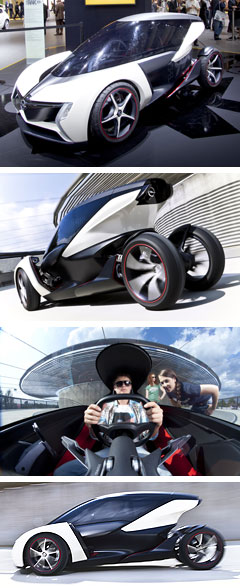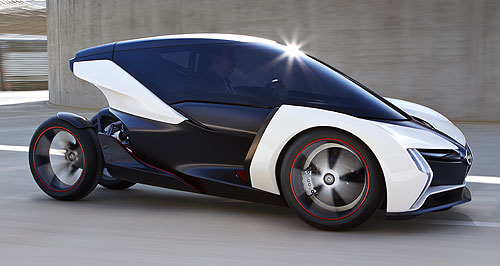Future models - Opel - Electric ConceptCrazy Opel commuter not just for showOpel confirms it is developing a business case for radical RAK-e four-wheeled bike20 Sep 2011 OPEL has revealed its rakish ‘RAK-e’ commuter concept is more than just a radical show car by confirming it is developing a business case for the all-electric motorcycle-like two-seater that could cost less than $14,000. Opel design vice-president Mark Adams told GoAuto that development of the RAK-e, which was just one of a number of personal mobility concepts to debut at last week’s Frankfurt motor show, began a year ago with mass series production in mind. “We’ll have to see how this whole urban mobility market develops and we’re going to continue to explore and try new things, but I do think the world is changing and it’s changing at a hell of a pace now days, so we’ve got to be able to adapt to that,” he said. “We are looking at this among many other things in our shop. We are looking at what makes sense, we are not just playing for the sake of it. “We are in a new era of the automobile here, we are at this point where there is definitely momentum for electrification and therefore that opens up a broader portfolio potential. “Things are going to start radically changing in this current environment and we have to experiment and find these alternative ideas.” Mr Adams said the RAK-e would not translate directly into a production vehicle, but that it was an accurate representation of Opel’s blueprint for a showroom-ready commuter vehicle in the near future.  “Would every millimetre of this come through to production if we ever wanted to do this?” he said. “Not every millimetre but we truly believe that conceptually this really has a great opportunity.” Opel’s design chief said the part-car, part-motorcycle RAK-e, which appeared at Frankfurt alongside the Volkswagen group’s conceptually similar two-seat Urban Concept from Audi and the single-seat Nils show car from VW, started life as a single-seater. “We really worked hard on the interior package. The initial mule was a single-seater in the early stages, but that didn’t suit our brand value of flexibility and also made it very limiting for a young guy who wants to take his girlfriend or something, or even if you want to go shopping – if you don’t have the space to fit things in then it doesn’t make sense. So we then turned it into a tandem seating arrangement.” Mr Adams said rear seat of the RAK-e’s two-seater cockpit was designed to accommodate his 180cm-plus frame to make it as practical as possible. “In the early package buck I sat in the back seat and we lowered the centre section of the roof until it touched my head and then said ‘okay, now that’s the centre line of the car’. We really did do it so I could sit in the back of this car. “Normal window lines would go up (at the rear), but with the rear seat so close to the front seat in what really is a tight package the windowline steps down so you’ve got nice visibility out to the side of the person sitting in front of you. So the functionality works hand in hand with the style. “We also sculpted the seats in the opposite way to normal. We don’t have bolsters down low, we have them up high and the areas cut away from the rear passengers knees, to give them a nice open space. Even things like the opening roof remains below the typical garage height.” Opel says the RAK-e, which is named after the German car-maker’s rocket-powered world speed record-setting (238km/h) RAK2 of 1928, combines a rigid composite passenger compartment with a steel – rather than more expensive carbon-fibre or aluminium - spaceframe chassis and a zero-emissions electric motor to offer high levels of performance and safety at low cost. Neither Mr Adams nor Opel engineering vice-president Rita Forst would speculate on the car’s crash performance, saying only that it complied with all legal safety requirements. The RAK-e’s low 380kg kerb weight and ability to be governed at a top speed of 45km/h would allow 16-year-olds to drive it legally in Germany, while 0-100km/h acceleration is listed at 13 seconds. Opel will not confirm exactly what the RAK-e could cost as a production vehicle, but GM Europe chief Nick Reilly has said the electric tandem two-seater “is a very serious concept” that is currently the subject of a production feasibility study and could go on sale in the UK (as a Vauxhall) for around £9000 ($A13,825). Measuring just three metres long and 1190mm high, the RAK-e, features a car-like front-end with unique horizontally oriented spring/struts a motorcycle-style rear-end comprising a single swingarm and spring/damper with two rear wheels. Mr Adams said the RAK-e was originally designed as a three-wheeler with a single rear wheel, but a twin-tyre rear-end was settled on, featuring a narrower rear track that eliminates the need for a rear differential and individual rear brakes. “The rear track is narrow not just because it looks different - 600mm is the widest track you can have before you need a diff, so we really pulled that in as much as possible, which allows you to have the braking system on the central driveshaft as opposed to on each wheel, saving mass and cost. “We tried to steer away from super-expensive costs. The value equation was very important. It’s a good example of producing something that’s exciting and fresh and new but also realistic about the value equation that we need to bring these things to market.’Mr Adams said the plug-in electric RAK-e - which is claimed to deliver a 100km driving range, the capability to run at speeds up to 120km/h in ungoverned form and the ability to be fully recharged in three hours - was not just an inner-city cruiser. “This vehicle explores urban mobility for the future. You look around and 95 per cent of people on the urban commute are driving a big car and they’re on their own“Clearly as governments become more anti-car in city centres for local pollution effects etc, I strongly believe there’s going to be a big drive for some change in this urban type vehicle. “This is an experiment, this is something that we said we don’t want to just think about as a city-car, we want you to also have the ability to drive from outside the city, to be able to even go on an autobahn, keep up with traffic and then be able to go into the city for zero taxation or whatever. “That was the philosophy behind it and then in order to get the taxation and running costs down as much as possible we focused on weight reduction, which gives you a huge performance benefit but if you get under a certain window also allows you to enter a different taxation class, so that’s a big opportunity.”  Read moreAll future models Alfa Romeo Alfa Romeo Abarth Abarth Audi Audi Aston Martin Aston Martin BMW BMW Bentley Bentley Chrysler Chrysler Chevrolet Chevrolet Dodge Dodge Citroen Citroen Ferrari Ferrari DS DS Ford Ford Fiat Fiat FPV FPV Foton Foton Haval Haval Great Wall Great Wall Honda Honda Holden Holden Hyundai Hyundai HSV HSV Isuzu Isuzu Infiniti Infiniti Jeep Jeep Jaguar Jaguar Lamborghini Lamborghini Kia Kia Lexus Lexus Land Rover Land Rover Mazda Mazda Maserati Maserati Mercedes-Benz Mercedes-Benz McLaren McLaren Mini Mini Nissan Nissan Mitsubishi Mitsubishi Peugeot Peugeot Opel Opel Proton Proton Porsche Porsche Renault Renault Ram Ram Saab Saab Rolls-Royce Rolls-Royce Smart Smart Skoda Skoda Subaru Subaru SsangYong SsangYong Tesla Tesla Suzuki Suzuki Toyota Toyota Volvo VolvoMotor industry news |
Click to shareOpel modelsResearch Opel All future models Alfa Romeo Alfa Romeo Abarth Abarth Audi Audi Aston Martin Aston Martin BMW BMW Bentley Bentley Chrysler Chrysler Chevrolet Chevrolet Dodge Dodge Citroen Citroen Ferrari Ferrari DS DS Ford Ford Fiat Fiat FPV FPV Foton Foton Haval Haval Great Wall Great Wall Honda Honda Holden Holden Hyundai Hyundai HSV HSV Isuzu Isuzu Infiniti Infiniti Jeep Jeep Jaguar Jaguar Lamborghini Lamborghini Kia Kia Lexus Lexus Land Rover Land Rover Mazda Mazda Maserati Maserati Mercedes-Benz Mercedes-Benz McLaren McLaren Mini Mini Nissan Nissan Mitsubishi Mitsubishi Peugeot Peugeot Opel Opel Proton Proton Porsche Porsche Renault Renault Ram Ram Saab Saab Rolls-Royce Rolls-Royce Smart Smart Skoda Skoda Subaru Subaru SsangYong SsangYong Tesla Tesla Suzuki Suzuki Toyota Toyota Volvo VolvoMotor industry news |















Facebook Twitter Instagram